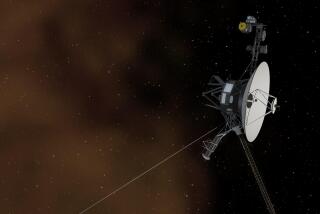Spaceship Gets Bounty of Data in Uranus Flyby
- Share via
The Voyager 2 spacecraft ripped past Uranus in a flawless performance Friday as it collected hundreds of photographs and mountains of data on the distant, icy planet.
The latest photographs taken while Voyager was on its final approach reveal mysterious features on some of the Uranian moons that scientists were at a loss to explain.
The 200 scientists gathered at the Jet Propulsion Laboratory will have to wait until today to receive their first data from the near encounter. But it should be well worth the wait.
Before this day is over, far more will be known, including much about the composition of the planet’s nine rings and perhaps even why the outer moons have such a mottled appearance.
In the latest photographs, some of the features are obvious impact craters from meteors, but others appear to have been the result of some sort of internal forces or some other form of geological trauma at some point in the history of the Uranian system, scientists said.
“The features that are not craters become very interesting because they say these are not static bodies,” said Brad Smith, head of the Voyager imaging team. “There’s something happening there.”
Link to Halley Probe
While Voyager offered nothing but good news as it examined one of the least known objects in the solar system, there was a touch of ominous news from another space venture.
The crown jewel of the armada of five international spacecraft en route to Halley’s comet lost communications for awhile with its command center in Germany, forcing the European Space Agency to turn to the Jet Propulsion Laboratory for help.
Richard Laeser, Voyager’s project manager, said the Europeans asked him to retarget one of California’s deep space antennas from Voyager to the Giotto spacecraft because the signal from the Halley probe had grown alarmingly weak.
“We are using just about all of the free world’s data gathering capabilities” for the Voyager mission, Laeser said. “I feel sort of like a bad guy, because we have put just about everybody else out of business.”
Two-Hour Diversion
Laeser nevertheless found that one of the antennas at the National Aeronautics and Space Administration’s Goldstone tracking station could be diverted from Voyager for about two hours without losing any of the precious data from the Uranus mission. The antenna gave the Europeans a chance to reestablish communications with Giotto and correct its problem, which apparently was an antenna on the spacecraft that was slightly out of whack. “They seem to have it squared away,” Laeser said later.
Giotto is to pass within about 300 miles of Halley’s nucleus March 13 in the most daring of all the Halley missions. Its problems proved to be a minor diversion for Laeser.
As project manager for Voyager, Laeser is chiefly responsible for running the spacecraft, and he beamed like a proud father after the craft completed its mission.
“I’m relieved,” he said.
The most frustrating part of the mission so far has been the delay in receiving data from the closest encounter. Voyager recorded its data on on-board recorders during the encounter but had to wait until after it had passed behind the planet to begin transmitting the information back to Earth.
Another Rendezvous
Voyager was to continue taking photographs and data from the other side of Uranus, including what should be spectacular, backlighted photographs of the planet’s rings, and then head on for Neptune for a rendezvous Aug. 24, 1989.
Early results from Voyager have confirmed most ground-based observations, revealing Uranus as an icy, gaseous planet. It also is now known to have a magnetic field so strong that it must be generated by a molten core in the middle of the planet.
Equally curious is the fact that the moons discovered by Voyager in orbits close to the planet are so dark that they reflect very little light.
“They are really like big lumps of coal as far as their reflectivity is concerned,” Smith said.
For the most part, Friday turned into a day of waiting for the scientists who have gathered at JPL near Pasadena for the encounter. They will spend the next few years sorting through the data that will come back over the next few days.






